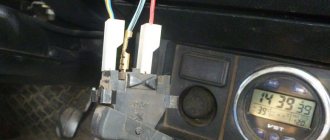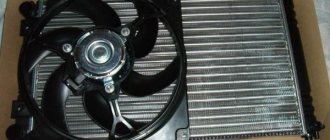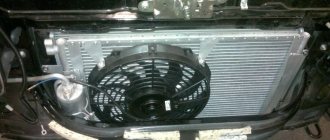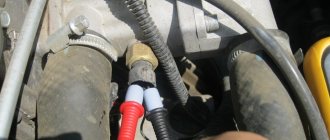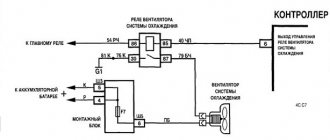Fortunately, users are much less likely to be puzzled by why the cooling fan of the VAZ 2114 is not working than to owners of other cars - fellow models. However, unfortunately, it is no longer possible to say that such a situation is completely unimaginable. It happens, and there is no escape from it.
On the other hand, any machine is a complex unit.
There is always something to break or become capricious. So, noticing that the arrow showing the temperature of your engine is confidently creeping into the red zone and is not going to stop, ease off the gas, turn on the fan in the cabin and look for the nearest hole where you can park your iron horse. You shouldn’t joke about overheating:
seized pistons are a full-fledged overhaul that will hurt your budget and nerves.
Related articles:
Why the VAZ 2114 cooling fan does not work
- there may be several reasons. They should be checked according to the decreasing degree of probability: the more often a given breakdown occurs, the closer to the top of the list is the object being checked.
"Salon" checks
Let's start with what can be examined without leaving the car.
2 fuses are responsible for the normal operation of the fan.
One of them also controls the operation of the beep, so it’s easy to check its viability: honk and listen. There is a sound - we forget about this fuse. No - we climb into the mounting block and look for the one marked F5
(20 amperes). Before putting a fresh one in the place of the burnt one, it would be useful to be curious about why the previous one burned out. Otherwise, the new one will face the same fate as its predecessor in the very short future.
With second fuse
It won't be easy to figure it out. To check it, you will have to dismantle the torpedo casing on the passenger side. 3 relays are hidden under it, accompanied by its own bodyguard-fuse. We need the one in the middle. It is pulled out and checked for integrity. If it burns out, before installing a new one, you will again need to find the cause of the breakdown. By the way, it will be good in this case if you have a spare one (both for checking and for replacing a burnt part).
If this fuse is also working, check the relay adjacent to it. Without an ohmmeter, it is impossible to determine whether it is alive or not; We can only suggest replacing it with a new one (then you need to carry it with you in reserve) and check whether the fan works. In any case, it is worth checking the condition of the contacts on the relay and, if necessary, cleaning them.
If no damage is found inside the car, you will have to get out of it and look for the reasons by opening the hood.
Fan connection 2108, 2109, 21099
Until 1998, on cars with the old mounting fuse block 17.3722 (finger type fuses), relay 113.3747 was included in the fan circuit. After 1998 there is no such relay.
Also, before 1998, the TM-108 switching sensor was used (the closing temperature of its contacts is 99±3ºС, the opening temperature is 94±3ºС), after 1998 the TM-108-10 with similar temperature ranges or its analogues from different manufacturers. The TM-108 sensor only works in conjunction with a relay; the TM-108-10, reinforced for high current, can work both with and without a relay.
Scheme for switching on the engine cooling fan on a VAZ 2109 with mounting block 17.3722
- Fan motor
- Motor start sensor
- Mounting block
- Ignition switch
K9 - Relay for turning on the fan motor. A - To terminal “30” of the generator
Scheme for switching on the engine cooling fan on a VAZ 2109 with mounting block 2114-3722010-60
- Fan motor
- Sensor 66.3710 for turning on the electric motor
- Mounting block
A - To terminal “30” of the generator
Engine compartment checks
After getting out of the car and lifting the lid, we proceed to more serious actions.
- The block on which the wires leading to the electric motor on the engine cooling fan are attached is disconnected;
- A pair of loose wires connect the motor to the battery. This will give us a clear picture: if the fan starts spinning, then we have a problem with the temperature sensor, if it remains motionless, the motor has burned out.
In the latter case, everything is clear
- you will have to change (or repair, if possible and have the appropriate skills) the fan motor. When a temperature sensor has failed, you need to avoid making the mistake of many and not confusing it with a sensor that records the temperature of the coolant. The one we need is located above the thermostat, directly on the cylinder head.
Where is the fan relay located?
It is located in an additional block.
4 – electric fan relay;
5 – electric fuel pump;
Relays and fuses may have a different order. Therefore, you need to focus on the color of the wires. The main relay is always located at the bottom. Find the relay that has a thin pink wire with a black stripe coming from it. It comes from the main relay through pin 85. Be careful! Do not confuse this with the red thin wire, which also has a black stripe and extends from the controller. And find a thick white wire with a black stripe (pin 87). This is where the cooling fan relay is located. There is always a fuse next to it. It is an element of the chain.
What to do?
This subsection is so named because professional auto mechanics strongly disagree that fan problems can have anything to do with the part mentioned below. Meanwhile, VAZ owners insist that following these instructions has a significant (and positive) effect on the cooling system in general and on the operation of its fan in particular.
Probably, the subtlety is not in the lid itself, but in the pickling valve, which reduces the pressure that has reached critical levels. But how the operation of the fan depends on it is a mystery shrouded in darkness. But it works! If you have already checked everything possible, but still don’t understand why the cooling fan of the VAZ 2114 does not work, try following the advice of experienced people and replacing the cover - maybe it will help.
The fan serves to generate air flows that are directed to the engine radiator. This is necessary in order to cool the liquid that circulates through it.
If the car is moving at high speed, the fan is not particularly required, since the engine receives all the necessary cooling from oncoming air flows. But when the car goes into slow driving or idle mode with the engine running, the role of the propeller becomes indispensable.
Switching on occurs after the corresponding signal is sent from the electronic control unit. The ECU, in turn, learns about the need to turn on the fan from the temperature sensor. The switching threshold is 103-105 degrees Celsius.
In the case of the VAZ 2114, the fan (propeller) is located in the engine compartment on the back side of the radiator.
Differences from its predecessor
In particular, the designers changed:
- the shape of the front wings;
- the shape of the headlights and side lights;
- back panel shape;
- hood and trunk lid.
As a result, the overall dimensions of the car also changed, but it remained the same front-wheel drive, four-door, five-seater sedan car.
Advice: video materials from thematic forums where VAZ 2115 owners share their impressions of year-round operation of the car can serve as a good help in evaluating a car.
Why doesn't it work
There are several reasons why the propeller may not turn on when the temperature situation requires it:
- The electric motor of the fan, that is, the drive, has failed;
- The fuse broke and burned out;
- Relay failed;
- The wiring is broken;
- The sensor connectors have lost contact;
- The sensor has failed.
Finding the fault
| Problem search area | Explanation |
| Propeller check | The connector on the propeller is disconnected and connected directly to the battery. If the fan starts working, everything is fine with the drive. If the propeller still does not spin, the problem is in the electric motor. |
| Wiring and contacts | If the propeller does not work, you must check the condition of the wiring and make sure that the sensor contacts are working properly |
| You can find these two elements in the engine compartment on the left, closer to the driver, inside the mounting block. The fan is supplied with a fuse designated F4 with a rated current of 20A. The test can be performed by pressing the horn button. Why? Yes, because it is also connected to this fuse. Or check with a tester | |
| It is located in the same place as the fuse. For an effective test, it is best to take a relay that you are 100% sure is working, install it in place of the old one and check | |
| To test the sensor, disconnect power from it. If it works, the propeller will start working in emergency mode, that is, it will blow constantly. Disconnect the connector and turn on the ignition. If the propeller spins, then the sensor is broken. Need replacement |
When to change
If the fan itself is the cause of all the problems, it is not necessary to change it, since in some cases it can be repaired. Failures are often associated with bearings or brushes.
If the cause of the breakdown is the failure of the electric motor due to a broken wiring or short circuit, it is not worth the risk of repairing it. It is easier and better to replace the entire drive.
If you drive a car that does not have a cooling propeller, this will lead to overheating of the coolant and destruction of pipes, rubber elements, gaskets of the main cylinder block and valve covers. It is not far from destroying the components of the piston group.
Operating a vehicle with a broken fan is strictly prohibited.
Price issue
Before starting to solve the problem of a radiator propeller not working, it is important for many people to learn about the cost of components and labor.
A new element today will cost approximately 1.5-2.5 thousand rubles, depending on the model and region. The cost of replacement at a service station will be from 400 rubles and more. Although it is not necessary to spend money on this, since replacing it yourself will take you no more than half an hour. Yes, and there is nothing particularly complicated here.
Conclusions: what exactly should be done if the fan does not work (action algorithm)
First, check whether the “plus” is connected to one of the terminals in the connector. Then connect the connector from ground to check the serviceability of the electric motor. In some cases, you can observe this:
- Both fuse F5 and the additional fuse are working;
- The fan relay operates as expected;
- The DTOZh sensor is working;
- The motor can only be turned on by applying a potential of “0 Volt”.
There will be only one conclusion: the ground contact has come loose, which ends the entire power line. This means you will need to contact an auto electrician. All other faults can be overcome by yourself.
Element F5 may burn out as a result of the horn closing. But then “+12” is not called up on the connector, which should immediately alert you.
Replacement
In order to replace the fan cooling propeller with your own hands, you will need a fairly small set of tools, which includes:
- Crosshead screwdriver;
- 8 mm socket wrench;
- 10mm socket wrench.
If you are ready, then let's get started.
- Place the car on a level surface and apply the handbrake. Just in case, you can put additional supports under the wheels of your VAZ 2114. It never hurts to take precautions.
- Raise the hood and disconnect the negative terminal from the battery.
- Using a 10 mm wrench, the fasteners of the air filter housing are removed.
- Armed with a screwdriver, loosen the clamp from the air duct located on the mass air flow sensor. This way you can remove the corrugation. Do it.
- There are screws on the air filter housing cover that hold it in place. They are unscrewed with a screwdriver, after which the filter component is removed from its seat.
- Now take an 8 mm wrench and use it to remove the air intake fasteners, and then remove the air intake itself.
- Now, using a 10 and 8 mm wrench, remove the fastening nuts on the fan casing around the entire perimeter. In total you will find 6 nuts there.
- Unplug the wire from the connector of your broken fan.
- Remove the fan casing, while also grabbing the drive, that is, the electric motor.
- Armed with a 10 mm wrench, you need to remove the three mounting bolts that hold the electric motor to the casing.
- Install the new fan in place of the old device.
- We return all the fasteners to their places, connect the connectors, and perform the assembly in the reverse order.
After installing new equipment, be sure to turn on the engine and let it run for a while. Until the fan turns on and the propeller starts spinning. This will take no more than 5 minutes. Soon the fan should turn off on its own. If it does not stop, turn off the engine. Repeat the experiment.
The electric fan of the VAZ-2114 engine cooling system is activated only by a signal from the coolant temperature sensor. But the connection does not occur directly, but through a relay. Two fuses protect this electrical circuit. If the temperature gauge needle creeps into the red zone of the scale, then let off the gas, turn on the interior heater fan at full power and look for a place to stop.
.
The serviceability of one of the fuses, located in the mounting block and protecting the electrical circuit of the fan, can be checked by simply pressing the horn button. If the signal works, then everything is in order with the fuse, since it also protects the electrical circuit of the sound signal. If it malfunctions, we open the mounting block and look for a 20-amp fuse F5, but before replacing it, you need to find the reason for its failure, otherwise the newly installed one will burn out in the same way.
To check the second fuse, you will have to remove the console trim on the passenger side. There you will see three relays and next to each of them there is a fuse. You will need to pull out the middle one to check. And again, if it burns out, you need to look for the cause of this phenomenon. If the fuse is working, we check the middle relay, since the fan motor is turned on through it. Having pulled it out of its socket, inspect its contacts for oxidation. You can check it with an ohmmeter; if you don’t have one or don’t know how to use it, you’ll have to try to replace it with a working one.
Next, open the hood, disconnect the block with wires from the fan motor and, if there are a pair of wires, connect it directly to the battery. If the fan starts working, then the cause of the malfunction will have to be looked for in the temperature sensor, or a relay and another fuse located next to this relay. Well, if the fan does not work when connected directly, then you will have to look for the fault in it yourself.
The fan may not work due to a failure of the temperature sensor for turning on the fan. It is located on the cylinder head, above the thermostat. If there is no ohmmeter, we check by replacing it. Only the fan switch sensor should not be confused with the sensor that works with the coolant temperature gauge.
Overheating of the engine threatens with serious consequences: the piston will jam, it will break, which will lead to a major overhaul of the power unit. Therefore, the cooling fan is an important element that protects the power unit from extreme heating.
Changing the fuse
- Fan relay not working
. What is not working is replaced by a new, working one;Changing the fan relay
- Open circuit in power supply
. If a break is detected in the line, you need to restore the wire or replace it;Checking for an open circuit
- Poor contact
. The connections are cleaned, traces of oxidation must be removed; - Temperature sensor failure
. .Changing the coolant temperature sensor
Video about replacing the fan switch sensor
Electrical circuit design of VAZ 2115
The VAZ wiring diagram is a single-wire circuit, which supplies the positive pole from the battery to the remaining elements of the circuit, and the negative pole is the housing.
The electrical circuit of the VAZ is protected from current surges in the form of fuses with fuse links. They were placed under the hood.
Fuses provide reliable protection for such expensive equipment as:
- the circuit in which the ignition switch is included;
- battery charging circuit;
- generator circuit and starter.
The VAZ electrical circuit includes relays that connect:
- headlight cleaners;
- emergency alarm;
- direction indicators;
- windshield cleaners;
- monitoring the serviceability of light bulbs;
- electric lifts;
- electric heated rear windows;
- horn;
- driving lights;
- low beam headlights.
The VAZ wiring diagram is made with wires of a certain color, which are designated by letters. A wiring harness of a certain color is secured with blocks.
The injection engine is controlled by a system that consists of a control unit - ECU - and sensors. The control unit occupies a central place in the fuel supply system. It has a second name - controller. It processes information received from sensors and controls systems that neutralize the toxicity of waste products and the performance of the machine.
There is a constant relationship between these elements - the controller and the sensors, which ensures uninterrupted operation of the drive.
The VAZ wiring diagram includes sensors with the following functions:
- fixing the position of the crankshaft: interacting with the ECU, it allows the car to move;
- throttle valve condition;
- fixing the position of the camshaft: injection is controlled;
- detonation (reacts to drive vibrations);
- monitoring mass air flow;
- coolant temperature control;
- speed control;
- idle control;
- control of oxygen concentration;
- fixation of the gas pedal state;
- control of the throttle valve drive.
By studying their operation, you can avoid the troubles caused by faulty sensors.
Thus, the VAZ electrical circuit made it possible to create a reliable and interesting car.
You can maintain it and maintain it in working order yourself, using the diagrams.
10.06.2014
On Samara 2113 2114 two engines are installed: 1.5i (Euro-2) 1.6i (Euro-2/3) 1.6i (Euro-3/4 e-gas).
Accordingly, we provide you with all the electrical equipment and engine power diagrams for these engines.
The photo shows a diagram of all electrical equipment on the VAZ 2115. Wire colors may vary. To enlarge a photo, click on it.
Checking the functionality of the cooling fan motor
The easiest way to check the operation of the fan is to put two straight wires on it: minus and plus.
The plus is taken from the battery, the minus from the car body. If it doesn’t work when the circuit is closed, then that’s where the problem lies. When starting the blades, we look for the problem elsewhere.
Cooling fan operation diagram
Basically, when a non-working fan is detected, several reasons are identified:
If in the last two cases the problem is solved with little effort, so to speak, the first involves replacing the electric motor.
Important! When installing wires, the main power supply to the electric motor must be disconnected.
Electrical diagram of VAZ 2113, 2114
To enlarge a photo, click on it. The diagram is presented in two parts with a description.
Electrical diagram of the engine control system 2111 1.5 liters with Euro-2 toxicity standard. To enlarge a photo, click on it. The diagram is presented in two parts with a description.
Electrical diagram of the Kalinovsky engine control system with Euro-2 toxicity standard.
Electrical diagram of the Kalinovsky engine control system with Euro-3 toxicity standard.
Procedure for checking
The operation of the fan on the VAZ-2114 is connected through 2 fuses. One of them is also responsible for the sound signal.
You can check it by pressing the horn. If there is no sound, replace it with a whole one. It is located in the mounting block, it is 20 ampere, marked F5.
Check and, if necessary, change fuses
The second one is located under the dashboard, on the passenger side.
Under the casing there are 3 relays with a fuse for each. The middle pair is responsible for the operation of the cooling fan. Replace the blown element with a new one (the fuse can be “ringed” with a multimeter or limited to a visual inspection. To check the functionality of the relay, you will need an ohmmeter). When checking their condition, at the same time make sure that the contacts are in normal condition, and if oxide is detected, clean them.
Important! If you find a blown fuse, you should not limit yourself to replacing it with a new one. It is imperative to find the cause of the break, since in the near future the new one will burn out again.
Checking the fan switch sensor
If the cause is not found, the next step should be to check the functionality of the fan switch sensor
. It's not difficult to do this. Disconnect it and turn on the ignition, while paying attention to the fan. The rotation of the blades indicates that the cause of the problem is in the sensor.
Checking the cooling system fan switch sensor
Due to the fact that very often the sensor begins to malfunction, sending erroneous signals, it is recommended to check it in another way
. To do this you will need a container, a thermometer and a multi-mert. Wires from the measuring device are connected to the sensor terminals, the threaded part of the sensor is immersed in the liquid. Heat the contents of the container to the temperature at which the fan operates (on a VAZ 2114 - 92 degrees). When the contacts close, the multimert will sound a sound signal. This means the sensor is working, if this does not happen, you can safely throw it away and buy a new one.
Healthy! Before installation, it is advisable to check the functionality of the purchased sensor in the same way.
Video about checking the cooling fan switch sensor
Final check
Having eliminated the problem, start the car engine. The fan motor should start after about 5 minutes of idling.
. If this does not happen, and the temperature has reached the desired level, diagnose the faults again.
Modifications of VAZ 2115
According to established tradition, the car could be equipped with a choice of two different power plants:
- engine with a displacement of 1.5 liters with a carburetor power supply system (the car of this configuration received the VAZ 2115-01 index);
- an engine of the same volume with distributed fuel injection VAZ 2111 and electronic control (the car of this configuration received the VAZ 2115-20 index).
Car electrical equipment
Thanks to different engines, the VAZ 2115 engine compartment wiring has its own design differences:
- the VAZ 2115-20 model has larger wiring harnesses due to the installation of additional sensors and electronic devices;
- The connectors of some electrical circuits have also changed;
- The layout of some of the wires has changed.
Advice: replacing the wiring of a VAZ 2115 is often accompanied by damage to the mounting clips. Do not neglect their absence, otherwise loose wires may end up too close to the hot engine.
Car electrical protection
The main power supply circuits of the electrical equipment of the VAZ 2115 car are protected from damage by fuses. Their price is small, but their help and impact are significant. After all, they protect more expensive equipment.
The exceptions are:
- battery charging circuit;
- ignition circuit;
- starter and generator power supply circuit.
Protection is realized using a fuse box assembled in the engine compartment. All powerful consumers, such as the starter, wipers and high beam lamps, are connected to the on-board network via a relay and are located in the mounting block.
For reference: the VAZ 2115 uses reusable bimetallic fuses to protect the electric motors of the windshield wipers, as well as the headlight units.
The graphic diagram of the mounting block below the symbols shows:
- F1–F20 – fuses for protecting vehicle electrical circuits;
- K1 - relay responsible for the operation of headlight cleaners;
- K2 - relay responsible for the operation of the alarm and direction indicators;
- K3 - relay responsible for the operation of the windshield wipers;
- K4 - relay for monitoring the health of incandescent lamps;
- K5 – relay responsible for the operation of electric windows;
- K6 – horn relay;
- K7 - relay responsible for the operation of the electric heated rear window;
- K8 - relay responsible for the operation of high beam headlights;
- K9 is a relay responsible for the operation of low beam headlights.
For reference: the incandescent fog lamps in the rear lights, together with the power indicator lamp, are protected by a separate fuse. It is located in the cabin under the dashboard in the wiring harness near the fog light switch.
Video about the reasons why the cooling fan on the VAZ-2114 does not turn on
The fan serves to generate air flows that are directed to the engine radiator. This is necessary in order to cool the liquid that circulates through it.
If the car is moving at high speed, the fan is not particularly required, since the engine receives all the necessary cooling from oncoming air flows. But when the car goes into slow driving or idle mode with the engine running, the role of the propeller becomes indispensable.
Searched device
Switching on occurs after the corresponding signal is sent from the electronic control unit. The ECU, in turn, learns about the need to turn on the fan from the temperature sensor. The switching threshold is 103-105 degrees Celsius.
In the case of the VAZ 2114, the fan (propeller) is located in the engine compartment on the back side of the radiator.
conclusions
It was determined that the normal operating temperature of the VAZ-2114 coolant is 85-105 degrees Celsius.
In this case, the temperature at which the cooling fan turns on will be 105 degrees Celsius.
The fan is designed to create an artificial air flow directed at the engine radiator in order to cool the liquid circulating in it. When the car is moving at high speed, there is, of course, no particular need for it, but at low speeds, and also when the car is idle with the engine running, you cannot do without it.
The radiator fan is turned on by a signal from the electronic control unit based on data received from the temperature sensor, which is triggered when the coolant heats up to 103-1050C. In a VAZ 2114 car, the fan is located in the engine compartment on the back side of the radiator.
Why doesn't it work
There are several reasons why the propeller may not turn on when the temperature situation requires it:
- The electric motor of the fan, that is, the drive, has failed;
- The fuse broke and burned out;
- Relay failed;
- The wiring is broken;
- The sensor connectors have lost contact;
- The sensor has failed.
Finding the fault
| Problem search area | Explanation |
| Propeller check | The connector on the propeller is disconnected and connected directly to the battery. If the fan starts working, everything is fine with the drive. If the propeller still does not spin, the problem is in the electric motor. |
| Wiring and contacts | If the propeller does not work, you must check the condition of the wiring and make sure that the sensor contacts are working properly |
| Fuse | You can find these two elements in the engine compartment on the left, closer to the driver, inside the mounting block. The fan is supplied with a fuse designated F4 with a rated current of 20A. The test can be performed by pressing the horn button. Why? Yes, because it is also connected to this fuse. Or check with a tester |
| It is located in the same place as the fuse. For an effective test, it is best to take a relay that you are 100% sure is working, install it in place of the old one and check | |
| To test the sensor, disconnect power from it. If it works, the propeller will start working in emergency mode, that is, it will blow constantly. Disconnect the connector and turn on the ignition. If the propeller spins, then the sensor is broken. Need replacement |
When to change
If the fan itself is the cause of all the problems, it is not necessary to change it, since in some cases it can be repaired. Failures are often associated with bearings or brushes.
If the cause of the breakdown is the failure of the electric motor due to a broken wiring or short circuit, it is not worth the risk of repairing it. It is easier and better to replace the entire drive.
Checking for open circuit
If you drive a car that does not have a cooling propeller, this will lead to overheating of the coolant and destruction of pipes, rubber elements, gaskets of the main cylinder block and valve covers. It is not far from destroying the components of the piston group.
Fuse
Operating a vehicle with a broken fan is strictly prohibited.
Price issue
Before starting to solve the problem of a radiator propeller not working, it is important for many people to learn about the cost of components and labor.
A new element today will cost approximately 1.5-2.5 thousand rubles, depending on the model and region. The cost of replacement at a service station will be from 400 rubles and more. Although it is not necessary to spend money on this, since replacing it yourself will take you no more than half an hour. Yes, and there is nothing particularly complicated here.
temperature sensor
Causes of malfunctions
The fan may not turn on for the following reasons:
- the fan drive (electric motor) is faulty;
- fuse is blown;
- the relay has failed;
- broken electrical wiring;
- lack of contact in the temperature sensor connector;
- The temperature sensor is faulty.
Search for reasons
Diagnosis of a fan malfunction should begin with the fan itself. To do this, disconnect the connector on the fan and connect it, observing the polarity, directly to the battery terminals. If it turns on, it means the drive is working, the reason needs to be looked for further. If the fan does not work, this is the reason. But let's take things in order.
The fan did not turn on. We check the integrity of the wiring and the condition of the contacts on the sensor. If everything is in order, we move on to the fuse and fan relay. They are located under the hood on the left side closer to the driver, in the mounting block.
Fuse F4 is 20A, double, for the sound signal and the cooling fan (it is very easy to check; if there is no sound signal and the fan does not work, then most likely it is the culprit).
You can check the fuse with an ordinary autotester. With relays the situation is more complicated. To make sure that this is not the case, it is better to get a one hundred percent working relay somewhere and temporarily install it in the socket for testing. If the fan does not work even with it, we go to the sensor.
If the sensor is de-energized, the controller must start the fan in emergency mode for constant blowing. Disconnect the connector from it and turn on the ignition. Turning on the fan will indicate that the sensor has failed and requires replacement.
When is it necessary to change a fan?
If the cause is still in the fan itself, you can try to repair it. The problem is usually the brushes or bearings. But it also happens that the electric motor fails due to a short circuit or break in the windings. In such cases, it is better not to experiment and replace the entire drive.
It is strictly forbidden to operate a vehicle with a non-working cooling fan. Overheating of the coolant will inevitably lead to the destruction of rubber pipes and hoses, as well as cylinder head gaskets and valve covers. In addition, high engine temperature can cause destruction of the piston group elements.
How much does a cooling fan cost on a VAZ 2114
You can buy a new cooling fan for a VAZ 2114 for 1500-2500 rubles. Replacing this part at a service station will cost 300-400 rubles. But you don’t have to spend money on this. Dismantling the old fan and installing a new one at home will take no more than 30 minutes.
Replacement
In order to replace the fan cooling propeller with your own hands, you will need a fairly small set of tools, which includes:
- Crosshead screwdriver;
- 8 mm socket wrench;
- 10mm socket wrench.
If you are ready, then let's get started.
- Place the car on a level surface and apply the handbrake. Just in case, you can put additional supports under the wheels of your VAZ 2114. It never hurts to take precautions.
- Raise the hood and disconnect the negative terminal from the battery.
- Using a 10 mm wrench, the fasteners of the air filter housing are removed.
- Armed with a screwdriver, loosen the clamp from the air duct located on the mass air flow sensor. This way you can remove the corrugation. Do it.
- There are screws on the air filter housing cover that hold it in place. They are unscrewed with a screwdriver, after which the filter component is removed from its seat.
- Now take an 8 mm wrench and use it to remove the air intake fasteners, and then remove the air intake itself.
- Now, using a 10 and 8 mm wrench, remove the fastening nuts on the fan casing around the entire perimeter. In total you will find 6 nuts there.
- Unplug the wire from the connector of your broken fan.
- Remove the fan casing, while also grabbing the drive, that is, the electric motor.
- Armed with a 10 mm wrench, you need to remove the three mounting bolts that hold the electric motor to the casing.
- Install the new fan in place of the old device.
- We return all the fasteners to their places, connect the connectors, and perform the assembly in the reverse order.
After installing new equipment, be sure to turn on the engine and let it run for a while. Until the fan turns on and the propeller starts spinning. This will take no more than 5 minutes. Soon the fan should turn off on its own. If it does not stop, turn off the engine. Repeat the experiment.
It rarely turns out that after replacement the fan still does not work. Even if this happened, this is due to two possible events - other elements of the cooling system were damaged, or you purchased a non-working fan. Alas, given the number of fakes on the market, the second option cannot be ruled out.
How to replace a temperature sensor
Before starting work, you need to partially drain the coolant from the cylinder block.
- Remove the wire.
- Using a 21 wrench, unscrew the temperature sensor.
- Take it off.
- Install the new one in reverse order.
Purpose of fuses
What fuses are on the VAZ 2114? The electrical circuit of this car is designed in such a way that in front of all the main electrical units there are chargers located in the fuse box.
VAZ 2114 fuse diagram
The connection diagram of these protective devices is shown in the figure.
- F1 - rated insert current 10 A - protects the fog lamps located at the rear.
- F2 - with a current of 10 A - these are left and right turn lights, an emergency warning light, a relay-breaker for turn lights and emergency lights.
- F3 - with a current of 7.5 A - protection of light bulbs in the cabin and trunk, trip computer circuits, ignition and brake lights, "Check engine" warning light.
- F4 - with a current of 20 A - protects switches located in the heating circuit of the trunk door glass and heating elements of this glass, “carrying” contacts.
- F5 - with a current of 20 A - protects the horn circuit and its switch, as well as the electric motor of the cooling system fan.
- F6 - with a current of 30 A - this is a circuit of electric windows and their switches with contacts.
- F7 - with a current of 30 A - a protective device for three electrical units - a heater, a windshield washer and a headlight cleaner. In addition, there is also a cigarette lighter, glove compartment lighting and winding for the heating switch for the trunk door glass.
- F8 - with a current of 7.5 A - is protection for the right fog light bulb located in front.
- F9 - with a current of 7.5 A - this is protection for the left fog light bulb located in front.
- F10 - with a current of 7.5 A - protects the indicator lights on the left side, the license plate number, the engine compartment light, the dashboard lights and switches with heating levers, as well as the indicator lights for the size.
- F11 - with a current of 7.5 A - protects the right-side headlight bulbs.
- F12 - with a current of 7.5 A - a protective device for the right low beam headlight bulb.
- F13 - with a current of 7.5 A - a protective device for the left low beam headlight bulb.
- F14 - with a current of 7.5 A - protects the left high beam headlight and the blue high beam warning light.
- F15 - with a current of 7.5 A - protects the right high beam headlight.
- F16 - with a current of 15 A - protects the light bulbs and the turn switch and hazard warning lights, the white reverse light, the power supply of the instrument cluster, the trip computer, the generator winding (at startup), the lights indicating low oil pressure, brake fluid and parking brake, battery discharge.

